Today, I'd like to discuss my experience with the Gerber natural dye experiment. The Gerber dye experiment is set forth in Frederick Gerber’s book [The Investigative Method of Natural Dyeing](https://www.amazon.com/investigative-method-natural-dyeing-articles/dp/0960181423/ref=asap_bc?ie=UTF8) and proposes a method to dye samples of a yarn to show a full range of natural colors from one dye material while using a range of modifiers. It requires that you start with a single dye material and a white yarn, divided into many mini skeins. In my case, I began with 2.9oz of Cormo fleece. Cormo is a very fine, springy wool and it takes dye well. 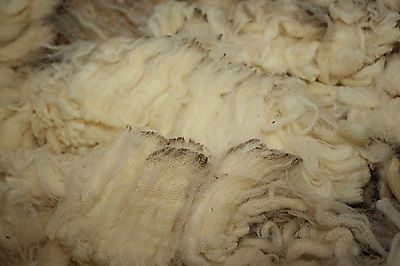 After scouring the wool, I spun it into a fingering-weight yarn that I then divided into fifteen equal length skeins. These skeins were labeled with numbers so I could record which 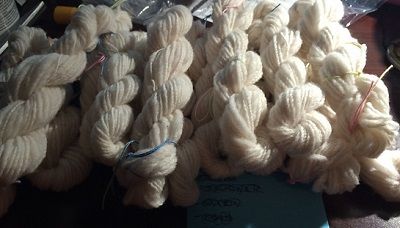.jpg) While I don't have pictures during the dye process for this project (the processing portion wasn't very photogenic, I'm afraid.) I will explain the process. First, I used cochineal as my natural dye. Cochineal is an insect which is harvested for its production of carminic acid, which produces a brilliant red dye. Believe it or not, carminic acid is often used as a colorant for foods and makeups. The first step to natural dyeing is to mordant the wool. A mordant is a heavy metal which acts as the bond between fiber and dye. If you do try natural dyeing, please make sure you have a separate set of pots from the ones you make food in. Also use gloves and a mask and always dye in a well-ventilated area. In this case, I pre-mordanted the wools. Half my skeins went into a pot of water with alum and the other half when into a pot with chrome. These pots were left overnight and then the skeins rinsed in the morning. The next day, Cochineal went in two pots, one for the chrome and one for the alum skeins. The skeins were simmered for an hour. Remember not to boil wool yarn, unless you want to end up with a matted piece of felt. The third step is where the magic happens. I divided the dye liquid and skeins into 15 jars, 7 alum jars and 8 chrome jars and modified them as shown in the chart below. <center>Mordant/Modifier</center> | <center>Alum</center> | <center>Chrome</center> --------------|----------------|--------------- Tin | X | X Tin & Ammonia | X | X Iron | X | X Iron & Ammonia | X | X Copper | X | X Copper & Ammonia | X | X Ammonia | X | X Alum | | X 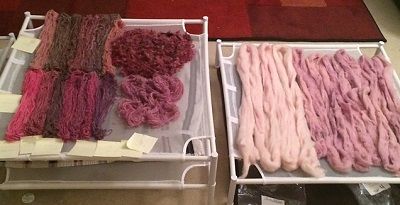.jpg) Each modifier changes the shade of red. Ammonia changes the pH and brightens the color. Copper adds a green overtone. Iron darkens the color and tin is considered neutral. In the photo above, the top row is the chrome pre-mordant, the bottom row is the alum pre-mordant. I also had some dye exhaust and was able to dye some wool tops and yarns I had on hand lovely shades of pink. 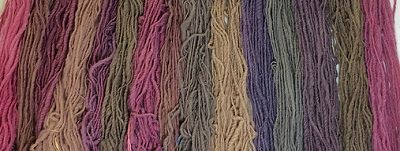 After some time, the colors changed. While pH can change the colors, in this case, it as because of light exposure. Chrome is light sensitive, and as a result, these skeins shifted to red-greys after exposed to light. I wanted to use all of the skeins in one project. A mini-shawl with basic stitches really showed off the color shifts. 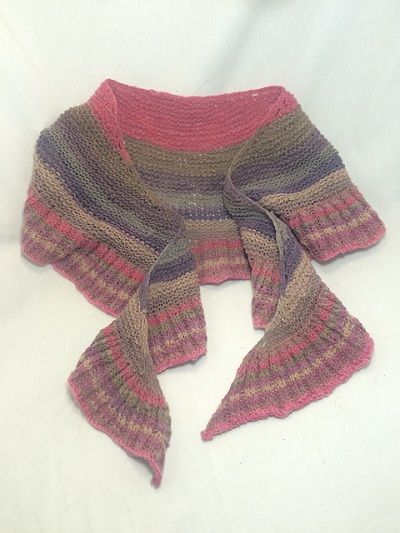 If you are planning to get into natural dyeing, I encourage you to dig deeper. It can be both more and less complex than the experiment as it is presented here, sometimes in the same sentence, and there are many great resources that discuss ways of mordanting wool and proper handling of tools and chemicals. Definitions ----------------- <br>**Coachineal -** An insect which produces carminic acid, a brilliant red dye **Modifier -** Anything which changes the color of the dye. A mordant can modify, as can pH with some dyes. **Mordant -** A heavy metal which acts as the bond between fiber and dye. ---------------- <center>.png) *All photos and text property of @luthvarian* </center>
| author | luthvarian |
|---|---|
| permlink | an-overview-of-a-dye-experiment |
| category | sustainability |
| json_metadata | {"tags":["sustainability","art","fiberarts","creativity","yarn"],"users":["luthvarian"],"image":["https://steemitimages.com/DQmPARcd6BmYbQf5YXboxSm3FFjxDrcySWgWjJ1VtKsMigm/il_570xN.743425891_e308_1__medium_1__medium.jpg","https://steemitimages.com/DQmVV6BDcMszt5jp8f82xVymEbnkt9sgV1sG41Mr7HEGF4R/image_medium2%20(3).jpg","https://steemitimages.com/DQmURe7MdChnrZRXnTbFTuSaaK1jJoUNiSzCi1fp7Yxjc1v/image_medium2%20(4).jpg","https://steemitimages.com/DQma6cDRtp69Lize2fiJ25THJoptv3Wutkaqk1DsfzQxkmG/image_medium2.jpg","https://steemitimages.com/DQmac6bHp3nKki3pLyoNZ8mhX9GcZFRFUp9fvGUG6okXBrH/File_000__26__medium2.jpeg","https://steemitimages.com/DQmPKx4M6s9zkC5HMKzTkcua4VsCS5xwYrq7VsHMgDjjYRH/luthlogobanner%20(1).png"],"links":["https://www.amazon.com/investigative-method-natural-dyeing-articles/dp/0960181423/ref=asap_bc?ie=UTF8"],"app":"steemit/0.1","format":"markdown"} |
| created | 2018-01-24 20:33:24 |
| last_update | 2018-01-24 21:56:45 |
| depth | 0 |
| children | 4 |
| last_payout | 2018-01-31 20:33:24 |
| cashout_time | 1969-12-31 23:59:59 |
| total_payout_value | 0.866 HBD |
| curator_payout_value | 0.267 HBD |
| pending_payout_value | 0.000 HBD |
| promoted | 0.000 HBD |
| body_length | 4,663 |
| author_reputation | 2,631,827,649,111 |
| root_title | "An Overview of a Dye Experiment" |
| beneficiaries | [] |
| max_accepted_payout | 1,000,000.000 HBD |
| percent_hbd | 10,000 |
| post_id | 32,012,992 |
| net_rshares | 114,071,968,304 |
| author_curate_reward | "" |
| voter | weight | wgt% | rshares | pct | time |
|---|---|---|---|---|---|
| clayboyn | 0 | 34,624,181,081 | 33% | ||
| thewoolynettle | 0 | 1,401,477,701 | 100% | ||
| carlgnash | 0 | 27,558,846,826 | 20% | ||
| sunravelme | 0 | 19,641,938,997 | 100% | ||
| dmiton | 0 | 53,018,161 | 1% | ||
| r-bot | 0 | 21,421,020,907 | 50% | ||
| d-vine | 0 | 8,246,845,308 | 50% | ||
| luthvarian | 0 | 781,106,147 | 100% | ||
| unityguild | 0 | 343,533,176 | 100% |
Beautiful, I love the more muted shades after some exposure to light. Looks like a successful experiment :)
| author | carlgnash |
|---|---|
| permlink | re-luthvarian-an-overview-of-a-dye-experiment-20180125t183814179z |
| category | sustainability |
| json_metadata | {"tags":["sustainability"],"app":"steemit/0.1"} |
| created | 2018-01-25 18:38:15 |
| last_update | 2018-01-25 18:38:15 |
| depth | 1 |
| children | 0 |
| last_payout | 2018-02-01 18:38:15 |
| cashout_time | 1969-12-31 23:59:59 |
| total_payout_value | 0.000 HBD |
| curator_payout_value | 0.000 HBD |
| pending_payout_value | 0.000 HBD |
| promoted | 0.000 HBD |
| body_length | 108 |
| author_reputation | 114,786,060,260,950 |
| root_title | "An Overview of a Dye Experiment" |
| beneficiaries | [] |
| max_accepted_payout | 1,000,000.000 HBD |
| percent_hbd | 10,000 |
| post_id | 32,266,826 |
| net_rshares | 869,983,326 |
| author_curate_reward | "" |
| voter | weight | wgt% | rshares | pct | time |
|---|---|---|---|---|---|
| luthvarian | 0 | 869,983,326 | 100% |
Wow @luthvarian, you really blow my mind with your in depth knowledge on the topic of natural dying. It is truly impressive. I admire your dedication to our mother earth & mankind, even if most don't appreciate it, yet! Being a strong supporter of environmentally friendly & non toxic clothing, I stand behind your engagement to show the world it can be done different! What you have created here is just magnificent <3 Thank you for your dedication & education on this matter! <3
| author | d-vine |
|---|---|
| permlink | re-luthvarian-an-overview-of-a-dye-experiment-20180124t213857680z |
| category | sustainability |
| json_metadata | {"tags":["sustainability"],"users":["luthvarian"],"app":"steemit/0.1"} |
| created | 2018-01-24 21:38:57 |
| last_update | 2018-01-24 21:40:30 |
| depth | 1 |
| children | 2 |
| last_payout | 2018-01-31 21:38:57 |
| cashout_time | 1969-12-31 23:59:59 |
| total_payout_value | 0.000 HBD |
| curator_payout_value | 0.000 HBD |
| pending_payout_value | 0.000 HBD |
| promoted | 0.000 HBD |
| body_length | 481 |
| author_reputation | 59,541,654,545,694 |
| root_title | "An Overview of a Dye Experiment" |
| beneficiaries | [] |
| max_accepted_payout | 1,000,000.000 HBD |
| percent_hbd | 10,000 |
| post_id | 32,024,800 |
| net_rshares | 0 |
Well, thank you. I plan to have some future posts with some more detailed tutorials geared toward beginner dyers, too. As a librarian by day, free and open access to information is one of my mantras. ;-)
| author | luthvarian |
|---|---|
| permlink | re-d-vine-re-luthvarian-an-overview-of-a-dye-experiment-20180125t161120799z |
| category | sustainability |
| json_metadata | {"tags":["sustainability"],"app":"steemit/0.1"} |
| created | 2018-01-25 16:11:21 |
| last_update | 2018-01-25 16:11:21 |
| depth | 2 |
| children | 1 |
| last_payout | 2018-02-01 16:11:21 |
| cashout_time | 1969-12-31 23:59:59 |
| total_payout_value | 0.000 HBD |
| curator_payout_value | 0.000 HBD |
| pending_payout_value | 0.000 HBD |
| promoted | 0.000 HBD |
| body_length | 205 |
| author_reputation | 2,631,827,649,111 |
| root_title | "An Overview of a Dye Experiment" |
| beneficiaries | [] |
| max_accepted_payout | 1,000,000.000 HBD |
| percent_hbd | 10,000 |
| post_id | 32,237,652 |
| net_rshares | 0 |
That sounds great @luthvarian! I will keep my eyes open!
| author | d-vine |
|---|---|
| permlink | re-luthvarian-re-d-vine-re-luthvarian-an-overview-of-a-dye-experiment-20180129t151220664z |
| category | sustainability |
| json_metadata | {"tags":["sustainability"],"users":["luthvarian"],"app":"steemit/0.1"} |
| created | 2018-01-29 15:12:21 |
| last_update | 2018-01-29 15:12:21 |
| depth | 3 |
| children | 0 |
| last_payout | 2018-02-05 15:12:21 |
| cashout_time | 1969-12-31 23:59:59 |
| total_payout_value | 0.000 HBD |
| curator_payout_value | 0.000 HBD |
| pending_payout_value | 0.000 HBD |
| promoted | 0.000 HBD |
| body_length | 56 |
| author_reputation | 59,541,654,545,694 |
| root_title | "An Overview of a Dye Experiment" |
| beneficiaries | [] |
| max_accepted_payout | 1,000,000.000 HBD |
| percent_hbd | 10,000 |
| post_id | 33,311,839 |
| net_rshares | 853,910,982 |
| author_curate_reward | "" |
| voter | weight | wgt% | rshares | pct | time |
|---|---|---|---|---|---|
| luthvarian | 0 | 853,910,982 | 100% |
 hiveblocks
hiveblocks